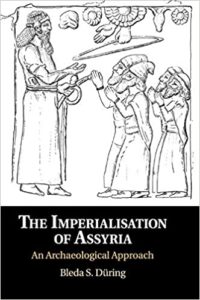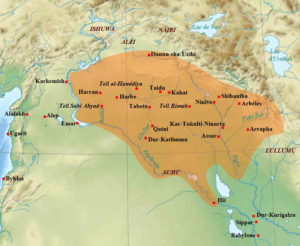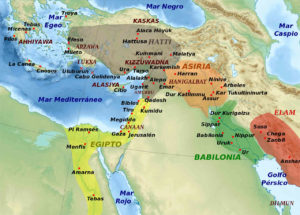DÜRING, B. S. The Imperialisation of Assyria: An Archaeological Approach. Cambridge: Cambridge University Press, 2020, 198 p. – ISBN 9781108478748.
Este estudo trata de um dos processos mais notáveis da história do Antigo Oriente Médio, que teve impactos significativos no desenvolvimento de longo prazo da Eurásia. Este desenvolvimento consiste no surgimento de formas sustentáveis de império e imperialismo.
Eurásia. Este desenvolvimento consiste no surgimento de formas sustentáveis de império e imperialismo.
O surgimento de impérios duráveis resultou em uma transformação total da dinâmica de poder inter-regional do mundo antigo. Essas infraestruturas imperiais acabaram por dar origem à ordem global do mundo moderno, na qual as ações de alguns governos poderosos têm repercussões em todo o globo.
Embora seja ingênuo argumentar por uma evolução direta das tradições imperiais da Assíria para o mundo moderno, argumentarei que os repertórios imperiais foram transmitidos e retrabalhados de um império para o outro, e que o imperialismo no mundo moderno tem suas raízes na passado profundo.
Os impérios se desenvolveram inicialmente em um número relativamente limitado de regiões do mundo, incluindo o Oriente Médio, China, Andes e Mesoamérica, e posteriormente se espalharam por grande parte do globo. Os primeiros impérios do mundo tomaram forma no Oriente Médio e tiveram um impacto decisivo na história subsequente da Eurásia ocidental, com a China assumindo um papel semelhante no Extremo Oriente.
O Antigo Oriente Médio deu origem a alguns dos primeiros impérios da história mundial. Os maiores estados do mundo estavam localizados na Mesopotâmia e no Egito mais de um milênio antes que um estado de tamanho similar surgisse na China, e somente na segunda metade do primeiro milênio AEC na Índia e no Mediterrâneo.
O Império Assírio foi o primeiro estado a alcançar o domínio duradouro do Antigo Oriente Médio, existindo por cerca de sete séculos [1350-612 AEC] e, eventualmente, controlando a maior parte da região.
A questão central deste estudo é: como explicar o sucesso do (Médio) Império Assírio [ca. 1350-1050 AEC]? Isso será feito ao longo de três linhas de investigação:
Em primeiro lugar, quais foram as circunstâncias e condições históricas em que o Império Assírio tomou forma e se reproduziu? Obviamente, a Assíria, como qualquer outro estado na história, foi determinada em grande medida por desenvolvimentos históricos mais amplos, por um lado, e eventos-chave, por outro, e precisamos mapear esse contexto histórico para entender o Império Assírio.
Em segundo lugar, que conjunto de tradições culturais estavam presentes na Assíria que ajudam a explicar seu sucesso como estado imperial? Como a Assíria desenvolveu seus repertórios imperiais, ou seja, as técnicas e estratégias usadas para alcançar e manter a dominação, e até que ponto esses repertórios imperiais eram particularmente assírios, ou vice-versa, vemos empréstimos de instituições e tecnologias de dominação imperial de impérios predecessores , como Mitani, e impérios contemporâneos, como o Egito do Reino Novo, os hititas e os cassitas.
Terceiro, para entender o Império Assírio, precisamos perguntar o que havia nele para as várias categorias de pessoas que faziam parte dele. No final, mesmo os estados imperiais mais poderosos podem ser desfeitos pelas ações das pessoas comuns, e a proeza imperial depende do equilíbrio da participação da população em geral. Assim, para entender a conquista imperial assíria, é essencial mapear os vários tipos de atores envolvidos e por que pessoas de diversas origens sociais e status sociais teriam optado por participar do projeto imperial assírio.
Para explorar essas questões, começarei discutindo o contexto mesopotâmico e sua história de fragmentação política, e discutirei por que essa região foi difícil de unificar em um império por um período substancial de tempo (Capítulo 1).
Em seguida, apresentarei a história inicial de Assur, como ela se tornou o núcleo do império assírio, e discutirei uma característica emergente que se tornaria um dos blocos de construção do império em tempos posteriores (Capítulo 2).
Posteriormente, discutirei as circunstâncias históricas e geográficas que tornaram possível a ascensão da Assíria (Capítulo 3).
Em seguida, discutirei o impacto variado da Assíria nos territórios conquistados e o que a heterogênea pegada arqueológica assíria nos diz sobre a natureza do imperialismo (Capítulo 4).
Em seguida, discutirei os repertórios imperiais, os recursos disponíveis para criar e manter o império e porque diversos povos optaram pelo projeto imperial assírio (Capítulo 5).
Por fim, discutirei como a Assíria se tornou o império predominante do Oriente Médio na Idade do Ferro e como essa conquista sem precedentes foi baseada no legado da Assíria Média (Capítulo 6).
O capítulo final (Conclusões) sintetizará as principais conclusões deste estudo.
Definindo Impérios
 Então, como podemos estudar impérios com base em dados arqueológicos?
Então, como podemos estudar impérios com base em dados arqueológicos?
Aqui argumenta-se que os impérios devem ser entendidos como estados extensos que incluem pelo menos dois estados regionais preexistentes e que o imperialismo deve ser entendido como o processo pelo qual a política dominante (ou sociedade metropolitana) cria e mantém controle efetivo sobre as políticas dominadas (sociedades provinciais e periféricas).
Os impérios, então, não são sistemas hegemônicos de cobrança de tributos que giram em torno de ideologia, culto e vida na corte – embora esses elementos sejam frequentemente ingredientes importantes dos impérios – mas devem ser entendidos acima de tudo como o esforço mais ou menos bem-sucedido para superar desafios logísticos de distância, bem como resistência e obstrução locais, que, se não forem atendidas adequadamente, inevitavelmente levarão ao colapso imperial.
Os fatores logísticos tiveram efeitos claros: primeiro, na economia pré-moderna, o que significava que os excedentes agrícolas só podiam ser consumidos localmente; segundo, as habilidades das elites imperiais para obter e compartilhar informações sobre desenvolvimentos em regiões distantes; e, terceiro, a capacidade das elites imperiais de intervir militarmente ou de outra forma em regiões distantes dos impérios. Para superar esses problemas, impérios precisavam ser estabelecidos e consolidados no centro, nas províncias, nas periferias e além, por meio de um amplo e flexível conjunto de repertórios imperiais, dos quais as elites e as cortes são apenas um componente.
Assim, defendo que o cerne da questão é como a hegemonia imperial é alcançada e mantida nos territórios conquistados, ou seja, nas províncias e periferias. Portanto, o imperialismo é um tipo particular de relação de poder de uma política imperial sobre sociedades subalternas, e um império é uma política que é bem-sucedida em seus esforços para manter esse tipo de relação de poder ao longo de gerações.
Fonte: Estes trechos foram traduzidos da Introdução, p. 1-4 e do Capítulo 1, Um mundo fragmentado, p. 5-26.
Bleda S. Düring é Professor de Arqueologia do Antigo Oriente Médio na Universidade de Leiden, Países Baixos.
This study deals with one of the most remarkable developments in the history of the Ancient Near East, which had significant impacts on the long-term development of Eurasia. This development consists of he rise of sustainable forms of empire and imperialism. The emergence of durable empires resulted in a total transformation of interregional power dynamics of the ancient world. These imperial infrastructures eventually gave rise to the global order of the modern world, in which the actions of a few powerful governments have repercussions across the globe. While it would be naive to argue for a direct evolution of imperial traditions from Assyria to the modern world, I will argue that imperial repertoires were transmitted and reworked from one empire to the next, and that imperialism in the modern world has its roots in the deep past.
Empires first developed in a relatively limited number of regions of the world, including the Near East, China, the Andes, and Meso-America, and subsequently spread to a large part of the globe. The earliest empires of the world took shape in the Near East, around 2300 BCE, and these had a decisive impact on the subsequent history of western Eurasia, with China taking on a similar role in the Far East.
The Ancient Near East gave rise to some of the earliest empires in world history. The largest states of the world were located in Mesopotamia and Egypt more than a millennium before a state of similar size emerged in China, and only in the second half of the first millennium BCE do comparably large political entities emerge in other regions such as India and the Mediterranean.
The central question of this study is: how can we explain the success of the (Middle) Assyrian Empire? This will be done along three lines of inquiry. First, what were the historical circumstances and conditions in which the Assyrian Empire took shape and was reproduced? Obviously, Assyria, like any other state in history, was determined to a significant extent by broader historical developments on the one hand, and key events, on the other, and we need to chart this historical context to understand the Assyrian Empire. Second, what set of cultural traditions were present in Assyria that help to explain its success as an imperial state? How did Assyria develop its imperial repertoires, that is the techniques and strategies used to achieve and maintain domination, and to what degree were these imperial repertoires particularly Assyrian, or vice versa, do we see borrowings of institution and technologies of imperial domination from predecessor empires, such as the Mittani, and contemporary empires, such as New Kingdom Egypt, the Hittites, and the Kassites. Third, to understand the Assyrian Empire we need to ask what was in it for the various categories of people who were part of it. In the end, even the most powerful imperial states can be undone through the actions of ordinary people, and imperial prowess depends on the balance of participation of the population at large. Thus, to understand the Assyrian imperial achievement, it is essential to map the various types of actors involved, and why people of diverse social backgrounds and social statuses would have opted into partaking into the Assyrian imperial project.
historical circumstances and conditions in which the Assyrian Empire took shape and was reproduced? Obviously, Assyria, like any other state in history, was determined to a significant extent by broader historical developments on the one hand, and key events, on the other, and we need to chart this historical context to understand the Assyrian Empire. Second, what set of cultural traditions were present in Assyria that help to explain its success as an imperial state? How did Assyria develop its imperial repertoires, that is the techniques and strategies used to achieve and maintain domination, and to what degree were these imperial repertoires particularly Assyrian, or vice versa, do we see borrowings of institution and technologies of imperial domination from predecessor empires, such as the Mittani, and contemporary empires, such as New Kingdom Egypt, the Hittites, and the Kassites. Third, to understand the Assyrian Empire we need to ask what was in it for the various categories of people who were part of it. In the end, even the most powerful imperial states can be undone through the actions of ordinary people, and imperial prowess depends on the balance of participation of the population at large. Thus, to understand the Assyrian imperial achievement, it is essential to map the various types of actors involved, and why people of diverse social backgrounds and social statuses would have opted into partaking into the Assyrian imperial project.
To explore these questions I will start by discussing the Mesopotamian context and its history of political fragmentation, and discuss why this region was difficult to unify in an empire for a substantial period of time (Chapter 1). Then I will introduce the early history of Assur, how it became the nucleus of the Assyrian empire, and will discuss an emergent distinctiveness that would become one of the building block of empire in later times (Chapter 2). Subsequently, I will discuss the historical and geographical circumstances that made the rise of Assyria possible (Chapter 3). Next, I will discuss the variegated impact of Assyria in conquered territories, and what the heterogeneous Assyrian archaeological footprint tells us about the nature of imperialism (Chapter 4). Following that, I will discuss the imperial repertoires, resources available to create and maintain the empire, and why diverse people opted into the Assyrian imperial project (Chapter 5). Lastly, I will discuss how Assyria became the predominant Near Eastern empire in the Iron Age, and how this unprecedented achievement was based on the Middle Assyrian legacy (Chapter 6); the final chapter (Conclusions) will summarise the main conclusions of this study (From Introduction, p. 1-4).
Defining Empires (p. 6)
 So how can we study empires on the basis of archaeological data? Here, following Doyle, it is argued that empires should be understood as expansive states that include at least two pre-existing regional states and that imperialism is to be understood as the process by which the dominating polity (or metropolitan society) creates and maintains effective control over the dominated polities (provincial and peripheral societies). Empires, then, are not tribute-taking hegemonial systems that revolve around ideology, cult, and court life – although these elements are often important ingredients of empires – but are above all to be understood as the more or less successful effort to overcome logistical challenges of distance as well as local resistance and obstruction, which, if not met adequately, will inevitably lead to imperial collapse.
So how can we study empires on the basis of archaeological data? Here, following Doyle, it is argued that empires should be understood as expansive states that include at least two pre-existing regional states and that imperialism is to be understood as the process by which the dominating polity (or metropolitan society) creates and maintains effective control over the dominated polities (provincial and peripheral societies). Empires, then, are not tribute-taking hegemonial systems that revolve around ideology, cult, and court life – although these elements are often important ingredients of empires – but are above all to be understood as the more or less successful effort to overcome logistical challenges of distance as well as local resistance and obstruction, which, if not met adequately, will inevitably lead to imperial collapse.
Logistical factors had clear effects on: first, the pre-modern economy, which meant that agricultural surpluses could only be consumed locally; second, the abilities of imperial elites to obtain and share information on developments in far-flung regions; and, third, the capabilities of imperial elites to intervene militarily or otherwise in far removed regions of empires. In order to overcome these problems, empires needed to be established and consolidated in the centre, the provinces, the peripheries and beyond through a broad and flexible set of imperial repertoires, of which elites and courts are only one component.
Thus, I argue that the crux of the matter is how imperial hegemony is achieved and maintained in conquered territories, that is, in the provinces and peripheries. Hence imperialism is a particular type of relationship of power of an imperial polity over subaltern societies, and an empire is a polity that is successful in its efforts to maintain this type of power relationship across generations.
Bleda S. Düring is Associate Professor in Near Eastern Archaeology at Universiteit Leiden. He is the author of The Prehistory of Asia Minor (2010) and co-editor, with Tesse Stek, of The Archaeology of Imperial Landscapes (Cambridge, 2018).
